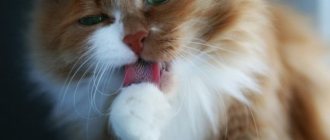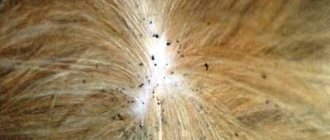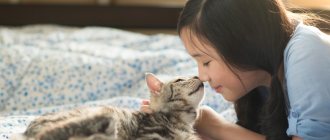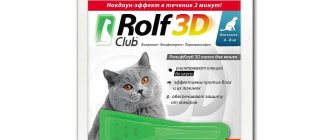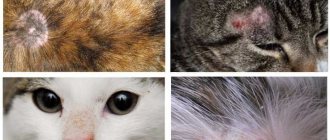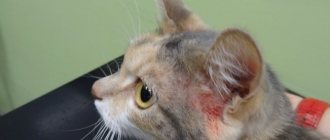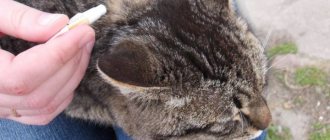If a cat licks under its tail no more than once a day, then this can be considered normal. Some pets pay increased attention to hygiene. But when this process becomes obsessive, licking may leave bald patches or even small wounds.
In such cases, the possibility of worms should be excluded first. Then they consider the option with fleas. Only after antiparasitic treatments can other causes be considered if symptoms persist.
What to do if your cat constantly licks under its tail?
If a cat licks under its tail no more than once a day, then this can be considered normal. Some pets pay increased attention to hygiene. But when this process becomes obsessive, licking may leave bald patches or even small wounds. In such cases, the possibility of worms should be excluded first. Then they consider the option with fleas. Only after antiparasitic treatments can other causes be considered if symptoms persist.
Possible options
Every cat licks under its tail at least several times a week. This process should not be considered pathological, provided that the animal is regularly treated against fleas and ticks (at least once a month) and undergoes quarterly deworming. If you add accompanying symptoms such as redness in the anus, discharge or the appearance of growths, it is recommended to exclude the following diseases:
- Inflammation of the paraanal glands. It can form after eating bones, due to excess weight, soft food. Prolonged diarrhea can also be a cause. The first signs of inflammation may include fidgeting on the butt, constant licking under the tail, and redness in the anus. The problem can be solved by cleaning (at least once every three months, if there is a predisposition to inflammation). It is performed by a veterinarian in a hospital setting. After cleaning, ointments (proctosedyl) and suppositories (ichthyol or sea buckthorn) are prescribed. A change of food and increased hygiene are also indicated.
- Fleas. They can cause itching in different parts of the body. But most often bites occur on the base of the tail and stomach. Therefore, if a cat licks under its tail, behaves restlessly, tries to chew out fur, or tears itself with its paw until it bleeds, then flea treatment should be carried out. The fact that your pet does not leave the house is not 100% protection against parasites. The owner himself can bring them on clothes or the soles of shoes. Fleas are not dangerous to humans (they do not parasitize the skin), but in some cases they can bite. All animals are treated, regardless of the presence of symptoms. The most effective drugs are Stronghold and Frontline. They are produced in the form of drops, which are evenly applied to the withers so that the animal cannot lick the drug. It is recommended to perform this procedure at least once a month.
- Worms. The most common reason why a cat may lick under its tail frequently. Just like with fleas, an animal does not have to go outside to pick up parasites. He may develop them after being bitten by mosquitoes, mosquitoes, or fleas. Also at risk are pets whose diet contains raw meat and fish. Well, we cannot exclude the possibility that parasite eggs may enter the apartment on the soles of the shoes of the owner or his guests. The first signs of worms are itching in the anus, due to which the cat can ride on its butt on the floor. Licking and gnawing of fur in this area also indicate discomfort caused by parasites. Diarrhea, vomiting and increased appetite (or, conversely, complete refusal to eat) can be considered concomitant symptoms of helminthic infestation. Veterinarians recommend starting to worm animals from 3-4 weeks of age. As preparations, you can use tablets, suspensions or drops on the withers. Of the tablets, Drontal and Milbemax are considered the most effective. They can even be given in crushed form, adding to food. Some manufacturers offer meat-flavored tablets, since many pets flatly refuse to undergo deworming.
- Injury. This option cannot be ruled out. A pet can injure the anal area while climbing trees or after playing or fighting with other animals. Even a small scratch can cause significant discomfort. Because of this, a cat can constantly lick under its tail until it becomes bald. In such cases, it is recommended to carry out antiseptic treatment of the affected area until complete healing. And limit the animal's access to the wound using a special medical cap.
- Neoplasm. Unfortunately, this option should also be considered, especially if the animal is over 10 years old, it has been treated for parasites and there are no visible injuries in the anal area. The tumor can irritate the intestines, which explains the pet's restless behavior. The cat constantly licks under its tail, refuses to eat, and suffers from constipation. If necessary, the doctor performs diagnostic laparoscopy, during which cells are taken from the formation for histological examination. Depending on the type (sarcoma, lymphoma) of the tumor, treatment is selected (chemotherapy, surgical excision). Unfortunately, with tumors in the intestine, the prognosis is always cautious, even if the operation is successful and there are no metastases.
Preventive actions
Fungal and bacterial infections can be prevented by practicing good hygiene. Special medications and treatments will help protect your cat from lichen, dermatitis, otitis media and other diseases. For prevention, you need to regularly treat your pet against fleas, ticks and fungi, and also wash the bowl and tray with disinfectants. Bathing with a special shampoo is beneficial for cats. This procedure only needs to be done once a year.
Important! After treating a kitten with anti-flea or anti-fungal products, the animal should not be bathed. It is forbidden to wet the area where the medicine was applied.
The cat licks itself to help itself
Sanitizing the tray and bowl
All items belonging to the cat - bowl, tray, toys, etc. - must be regularly washed and treated with disinfectants. This will protect your pet from infectious, fungal, viral and other diseases. The bowl can be washed with regular dishwashing detergent. Usually fungus does not form on a cat's bowl, most often in the tray. It is advisable to treat it with any antifungal spray against lichen. Additionally, you can treat the tray with camphor alcohol, which not only cleans and disinfects the surface, but also eliminates unpleasant odors.
The bowl and tray should be washed and disinfected regularly
Special flea products
There are many treatments available at pet stores for fleas and other external parasites. They are available in the form of drops on the withers, sprays and collars. It is advisable to treat the cat with drops on the withers; this is the most effective remedy. The room can be sprayed with flea spray. Flea collars are not very effective. It does not destroy insects, but only repels them. A collar can only be put on a cat if it has recently been treated for fleas. Flea drops such as Leopard, Frontline, Advantage, Inspector, and Bolfo spray are very effective.
Flea remedies
The cat constantly licks itself: the reasons for this behavior
Absolutely every cat, regardless of breed, age and living conditions, tries to keep itself clean. Therefore, every day the pet is carefully licked several times - its fur coat, body, each paw in turn, tail and genitals. But sometimes the completely natural process of grooming an animal takes on the character of an obsession, and the cat constantly licks, and the reasons for this behavior are not always clear. This needs to be sorted out.
Cats usually lick and groom themselves after sleeping or eating. And this is normal, since cats are very clean by nature. But it happens that a cat begins to lick a specific place longer and longer. And for each situation there are reasons.
Reproduction
In cats and kittens, puberty occurs at the age of 6-8 months. It is at this time that they are ready to give birth. However, the age at which male cats are able to produce offspring may vary depending on the conditions of detention, breed, and nutrition. It is worth noting that puberty occurs earlier than the animal’s body is fully formed, so the first heat does not at all indicate readiness to give birth. Therefore, the best time for a cat to give birth is no earlier than 8-9 months.
Cats are polycyclic, characterized by sexual seasons and reflex ovulation. The sexual cycle is the changes that a cat's body goes through from ovulation to ovulation. Females are ready to mate only during estrus, males - at almost any period. If a cat is mated to several males, then the litter may contain kittens from different genetic fathers. At the age of approximately 10 years, animals stop hunting sexually (the manifestation of sexual reflexes).
When fertilized, the cat becomes pregnant and lasts about 60 days. Then childbirth takes place, during which 3 to 6 kittens appear. They are born without teeth, blind and deaf. The weight of a newborn kitten is no more than 70 grams. Childbirth lasts up to 5 hours, at the very beginning the cat begins to behave restlessly and makes a nest. When a kitten is born, the cat begins to lick it, bites through the membrane, removes it, and bites off the umbilical cord.
The cat licks and itches, but there are no fleas
Even if no fleas were visible during a visual inspection of the cat, this does not mean that there are none at all. Very often, small black grains are visible among the fur, very similar to trash - these are nits. And sometimes, small transparent bubbles – lice eggs – are attached to the pet’s hairs.
However, not only fleas can cause a cat to lick and itch. This can also be done by other pathological microorganisms, such as scabies mites. In this case, the pet will have visible skin damage on the ears, ankles and elbows.
Other possible reasons for your pet licking and scratching include:
- Allergies to food, plant pollen, hygiene products, or insect bites (the cat scratches its face, scratches its ears, intensively licks and bites its paws). In this case, the veterinarian will recommend a diet to test for any specific component of the food that is causing adverse effects.
- Fungal and bacterial inflammation. A set of certain fungi and bacteria are found on the skin and mucous membranes of both humans and their pets. Being in a normal state, these microorganisms do not harm. But if the immune system weakens, their number quickly increases, and inflammatory processes begin. Fungal inflammation causes severe itching.
- Otitis is an ear infection that causes itching. A cat with otitis media itches and displays the following signs: it scratches its face, furiously rubs its ears, and shakes its head; swelling and redness of the ears appears, and purulent discharge from the ears.
- Skin diseases (pyodermitis, notoedrosis, demodicosis, etc.) arise as a result of skin pathologies. The rashes that appear on the skin cause severe itching and discomfort. Scabies can also be accompanied by external signs such as baldness.
Urogenital pathologies
There are the following diseases of the genitourinary organs, in which the cat intensively licks under the tail:
- cystitis;
- urolithiasis disease;
- endometritis and pyometra
Cystitis
Cystitis Inflammation of the bladder due to hypothermia, unbalanced nutrition, infection of the genitals and urinary tract.
In addition to licking, it manifests itself with the following symptoms:
- urine first turns yellow, then becomes brown and foul-smelling;
- emptying of the bladder becomes more frequent, little fluid is released;
- the cat meows pitifully;
- leaves puddles everywhere.
Treatment consists of drinking plenty of fluids, fasting, rest and comfort. The veterinarian prescribes antimicrobial, immunomodulatory, and painkillers. In acute cases, the drug Stop-cystitis is prescribed. If the disease has reached a chronic stage, the herbal medicine Cat Erwin is used to relieve complications.
Prevention consists of proper nutrition, regular vaccinations, deworming, prevention of drafts and hypothermia
Urolithiasis disease
The disease is manifested by precipitation of urinary salts and injury to the urethra and ureters. The main reason is an unbalanced diet. Neutered men suffer most often. Pets that are overweight and do not exercise much are predisposed to the disease.
Clinical symptoms resemble cystitis, however, vomiting, refusal to feed, and convulsions are added. When the lumen of the urethra is blocked by stones, anuria develops, in which urine is not excreted. Acute attacks are relieved in a clinical setting. Conservative treatment and prevention include diet therapy. Veterinary feed is used.
Endometritis and pyometra
Inflammation of the uterine mucosa occurs as a result of pathological lambing or false pregnancy. A special role in the development of the disease is played by the uncontrolled use of hormonal contraceptives to disrupt estrus and unwanted pregnancy.
If conservative treatment is untimely or unsuccessful, the cervix closes and pyometra develops, a life-threatening condition. The optimal treatment is castration.
Be sure to read:
What to do if your cat has bald spots on its fur?
What to do if your cat is constantly licking
Having noticed that the cat has begun to lick and scratch almost all the time, and this is no longer simple self-care, the owner first of all needs to examine his pet for fleas. If fleas are not found, you need to remember whether one cat food was changed to another, whether a new shampoo was used, and whether any plant bloomed in the house.
A cat that scratches itself until it bleeds, licks itself and shakes its head frequently is most likely suffering from one of the skin diseases. You need to take her to the vet immediately. It will not be possible to make a diagnosis on your own, since scratching can be accompanied by many pathologies.
At the veterinary clinic, scrapings will be taken from the cat and microscopic and bacteriological studies will be carried out on their basis. They will allow you to identify fungal spores (if microsporia and trichophytosis occur) or mites (if demodicosis, sarcoptic mange or notoedrosis are present).
If the veterinarian suspects hormonal disorders, he may refer you for a blood test and, based on the results, will conduct an examination of the cat’s endocrine system.
How to check your cat yourself
It is impossible to diagnose cryptorchidism in a small kitten. The only thing you can do is look at his father and check if he has both testicles. At about six months of age, the cat's testes should have descended into the scrotum. If this does not happen in your pet (you can check it visually or by palpation), contact your veterinarian. The difficulty of diagnosing cryptorchidism depends on its type - inguinal is easy to identify, abdominal in some cases is difficult to detect even on ultrasound.
Did you know? Unscrupulous breeders often hide such defects, and the owners do not think to check the “completeness”, so in most cases cryptorchidism is discovered during a visit to the veterinarian.
Treatment
The veterinarian prescribes treatment not that concerns the itching, but that concerns the very cause of the disease. The course of treatment consists of taking medications and includes both local and internal medications. Depending on the cause of the disease, the veterinarian may prescribe antibiotics, antihistamines (to eliminate allergies), and antifungals.
If scabies and redness of the skin are caused by an allergy to food or hygiene products, their use will have to be stopped and the food replaced with another, in general, to get rid of all allergens.
Therapeutic measures
Any skin, parasitic or endocrine diseases should be treated immediately. The duration and method of treatment depends on the cause of the disease. If you have an allergy, you need to adjust your diet and remove the allergen. Ringworm is treated with antifungal ointments and tablets. For inflammatory and infectious diseases, a course of treatment with antibiotics and anti-inflammatory drugs is prescribed. Regardless of the cause of the disease, treatment always takes a long time: from 3 weeks to 2 months. It is necessary not only to help the cat stop itching, but also to completely eliminate the infection.
Treatment is prescribed depending on the cause of the disease
Preventing itching
Prevention of itching plays a very important role, so compliance with its basic measures will prevent the development of pathological processes accompanied by unpleasant symptoms.
Carry out hygiene procedures as often as possible - wet cleaning, washing cat bowls and washing their bedding.
Regularly clean your pet's ears and treat them with special medications.
Provide your pet with a balanced diet and try to prevent it from coming into contact with other animals.
Now everything has become clear why a cat can lick and itch. To solve the problem with a cat licking, you will have to be patient and time. And it doesn’t matter whether it’s a psychological or physiological reason. By providing your pet with enough attention and proper care, you can count on the fact that after some time his life will return to normal and his fur will be restored.
Licking due to stress
Frequent licking is not always associated with the physiological health of the animal. Perhaps some psychological aspect plays a role in such a situation. Cats like their lives to go on without much change, so any innovation can cause them anxiety. Redevelopment of the house, the appearance of new pets, change of regime and similar innovations cause emotional distress in cats.
Solving a licking problem requires a lot of patience and time, regardless of whether the cause is physiological or psychological. If you provide proper care and attention, then after some time the pet’s coat will be restored, and life will return to normal.
Did you like the article? Subscribe to the channel to stay up to date with the most interesting materials
Every cat lover has asked himself why cats lick themselves. This is a useful hygiene procedure for furry pets. The cat licks itself to remove dirt and loose hair from its fur. Licking is necessary for proper thermoregulation of the body and maintaining health. But there are situations when a cat constantly licks itself. This is often a sign of serious illness.
The cat constantly licks its tail - reasons and whether to worry
Absolutely every cat, regardless of its age, breed and living conditions, tries, as far as possible, to keep itself in ideal (by their standards) cleanliness. It is for this reason that the mustachioed pet carefully licks its fur, body, each paw, tail several times a day with great diligence and, of course, does not ignore its own genitals.
However, excessive zeal in the form of constant licking of the genital area can often alert vigilant owners and make them think about going to a specialist at the nearest veterinary clinic.
Reasons for this behavior
In cats, constant licking of the genitals can be caused by inflammation of the prepurcial sac - the so-called skin fold of the foreskin that forms the space between the head of the penis and the skin. The folds of skin contain preputial lubricant that surrounds the cat's penis.
whitish-yellow smegma of the foreskin, may occasionally accumulate along the entire perimeter of the preputial opening. Such discharge is considered normal by veterinarians. If for some reason an inflammatory process begins in the area of the foreskin, then this fluid includes inclusions of blood, pus or urine.
The reasons why a cat licks its tail may be as follows:
- Disease of the foreskin, including the occurrence of neoplasms (cancer) in this area, mechanical damage, balanoposthitis (inflammation of the foreskin).
- Diseases of the urethra: trauma, the formation of stones and their subsequent passage, neoplasia.
- Bladder diseases: stones, infectious inflammations, neoplasms,
- Pathology of the prostate gland: prostatitis, cysts, hyperplasia, neoplasms, abscess.
- Coagulopathy (bleeding) and thrombocytopenia that occurs in parallel with it (a decrease in the level of platelets in the blood) - such an ailment can be a consequence of poisoning with rat poison.
- Urinary incontinence - occurs due to displacement of the ureter, or improper functioning of the sphincter, which is responsible for the amount of urine released.
- The cat simply performs part of his daily toilet routine by thoroughly licking his genitals after going to the toilet.
- An animal can lick a wound under its tail. Surely every person has heard the point of view that a cat always heals itself by licking sore spots.
- A cat may lick under its tail due to the fact that it suffers from constipation; the painful sensations create constant torment for it, from which the pet tries to get rid of it in all available ways.
- Itching in the anus can also cause excessive licking under the tail; in this case, the owner should pay attention to the cat’s feces, if it contains traces of helminthic infestations, this particular cause must be gotten rid of.
- A cat may start licking its tail as a result of being in a stressful situation: moving to a new place of residence, castration, remodeling a house, having new family members or pets - absolutely all innovations can cause a cat to panic and plunge it into a depressive state.
Licking as a way to calm down
Animal psychologists have long noted the ability of four-legged animals to self-soothe.
. The cat's body is covered with hair, each hair grows from a follicle, to which nerve endings approach. Stroking is pleasant for the cat, since the contact of the hand with the fur simultaneously stimulates hundreds of nerve endings.
Animals tend to lick themselves when they feel anxious. Trying to relieve discomfort, the cat makes a lot of effort and licks itself with some “frenzy.” Lick granuloma in dogs and cats is the result of constant stress. The animal is so worried that it literally licks the fur and skin from its limbs. In advanced cases, bone can be easily seen in the affected area.
When a cat obsessively licks its owner and doesn’t stop, seeing the owner’s obvious dissatisfaction, it’s worth thinking about. Pets perfectly feel their owners, their experiences and emotions. Some lovers of four-legged animals are confident that cats can detect or cure disease. As observations have shown, mustachioed animals are sensitive to stress, fatigue and lack of sleep of the owner.
It's not obvious, but a tired person's body works differently. Metabolic processes slow down, and not only toxins, but also useful substances are released with sweat. Obviously, when there is a metabolic disorder, a person’s skin secretions (palms, armpits, legs, hair) smell change. Living in the wild, such a sleep-deprived and stressed individual would be easy prey, as the scent would alert predators to.
The conclusion is quite simple: the cat’s obsessive desire to lick the owner is associated with a feeling of care. The four-legged animal supports the person with all its might and instinctively helps him survive
. In this case, weaning a cat from licking can disrupt the harmony of the relationship. Judge for yourself, you will push your pet away in response to care. If you are sure that you are healthy and want to wean your pet from obsessive kisses, proceed as follows:
Distract your pet with dynamic play - the easiest way, but it has an unexpected consequence. A cat may begin to deliberately chase for the sake of wanting to play. Perhaps the ward should give in, he clearly lacks attention.
Use catnip to attract your pet's attention to toys and the scratching post. There is a chance that the cat will gradually switch its care to those who do not resist
Don't punish or push away, do everything gently. If you don't let your cat lick you, stand up and pretend to be busy. This way you will not offend your pet.
If your cat licks your hands, use a fur glove. Once the pet gets used to licking the glove, it will not need to be worn.
If you suspect that your four-legged dog is nervous or worried, hug him and hug him tightly (calculating your strength). External compression of muscles reduces tone and calms (not only animals).
The behavior of cats, when they purr, rub against their legs, climb onto their laps, or even sleep in their owners’ beds, is considered to be familiar and normal. Often, the manifestation of love and affection looks too intrusive - animals begin to actively lick the hands, face, ears and other parts of the human body
Such excessive tenderness can be determined not only by the pet’s desire to attract attention, but also by other motives
The first emotion a newborn kitten receives is maternal affection. Being blind and deaf, he feels a connection with his mother through tactile touches and then carries these feelings throughout his life. The cat, in turn, licks the kittens' bellies, pursuing other goals - it stimulates digestion and at the same time calms the babies, helping them relax and fall asleep. When a kitten is separated from its mother very early, it instinctively reaches out to a person, transferring its desire for love and care into adulthood.
Animals become especially vulnerable during puberty. If a cat is not sterilized on time and does not give birth, she may develop a so-called false pregnancy. If there is a close attachment to the owner, she has no choice but to “practice” her maternal instincts on a person. Hormonal imbalances often occur in non-castrated cats, which also begin to behave overly affectionately.
Important: in order not to provoke hormonal imbalance and subsequent health problems in your pets, it is advisable to carry out the procedure of sterilization or castration before the age of one year.
Diagnosis of the disease
If a cat constantly licks its tail, then it is worth talking about the presence of a disease that can only be determined by a veterinarian. The owner, turning to a veterinary clinic for help, will certainly be faced with the following procedures:
- Submission of general urine and blood tests, as well as biochemical blood tests,
- Submitting urine for bacterial culture (this action is necessary for specialists to exclude the presence of an infection in a pet located in the urinary tract area),
- Carrying out cytology and other bacterial studies,
- If bloody discharge appears, the animal will have to undergo coagulation; this procedure is also necessary to identify the cause related to blood clotting disorders,
- X-ray of the abdominal cavity (helps to identify the presence of an inflammatory process, for example, prostate disorders),
- Ultrasound of the abdominal cavity.
Diagnostic measures
To correctly determine the reason why a cat licks itself too often, the veterinarian performs a number of diagnostic procedures. To diagnose lichen, a Wood's lamp is used. After this, the doctor takes scrapings from the sore spot and damaged hairs from the cat. Then the skin sample taken is inoculated onto a nutrient medium. Additionally, blood is taken from the cat to test for infections. All procedures together will help you find out the cause of the disease and heal your pet from the disease.
A cat's fur is examined with a Wood's lamp to diagnose lichen.
